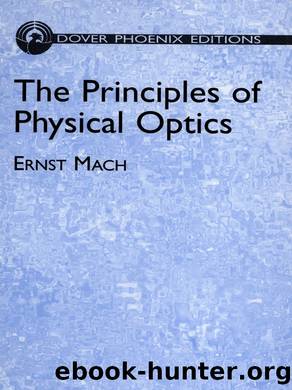The Principles of Physical Optics by Mach Ernst;

Author:Mach, Ernst; [Mach, Ernst]
Language: eng
Format: epub
ISBN: 1919800
Publisher: Dover Publications
Published: 2012-10-15T16:00:00+00:00
FIG. 163.
Further advance in the theory of the Newton’s rings was made by Poisson 237 who noticed an incompleteness in Fresnel’s theory in that only rays reflected once at the first and second surfaces of the air gap had been considered, these being of unequal intensity and consequently incapable of complete extinction, which is not in agreement with the fact that the monochromatic rings are in reality alternately bright and completely dark. He drew attention to the fact that light reaches the eye also after 3, 5, 7 . . . reflections in the air gap, and Fresnel then completed this part of the theory and showed that for reflected light the new theory gave perfectly black minima at the same positions as before.
While Newton had not found any material obstacle in his theory of “fits,” Fresnel 238 demonstrated its untenableness by means of the following experiment. He placed a glass prism P (Fig. 164) on a thin lens L whose under side was blackened with pitch, the lens also lying on the black surface SS and the prism projecting over the edge of the lens. If the dark rings which are visible were caused only by the transmission of the light by the second surface, that is with the suppression of reflection, it would be impossible for them to be darker than the reflecting prism surface where it extends past the lens; in reality, however, they are perfectly black. Arago, moreover, conceived a crucial test for the necessity of the joint action of the two rays, especially applicable to the case of Newton’s rings. Light incident at the polarizing angle on a plane parallel plate is reflected both from the first surface and from the second as light polarized in the plane of incidence. Thus, if a thin lens is laid on a metallic mirror and the combination is viewed, at the polarizing angle for glass, through an analyser with its plane of polarization perpendicular to the plane of incidence, the light reflected from both lens surfaces is extinguished, but that from the metal remains. No fringes, however, are visible. Hooke had already pointed out that reflection at the second surface was a necessary property of a lamina which exhibited colours, and this can also be proved in the above case by blackening the metal surface.
Download
This site does not store any files on its server. We only index and link to content provided by other sites. Please contact the content providers to delete copyright contents if any and email us, we'll remove relevant links or contents immediately.
The Complete Stick Figure Physics Tutorials by Allen Sarah(7135)
Secrets of Antigravity Propulsion: Tesla, UFOs, and Classified Aerospace Technology by Ph.D. Paul A. Laviolette(4974)
Thing Explainer by Randall Munroe(3782)
The River of Consciousness by Oliver Sacks(3412)
The Order of Time by Carlo Rovelli(3071)
How To by Randall Munroe(2911)
I Live in the Future & Here's How It Works by Nick Bilton(2839)
A Brief History of Time by Stephen Hawking(2819)
What If?: Serious Scientific Answers to Absurd Hypothetical Questions by Randall Munroe(2542)
The Great Unknown by Marcus du Sautoy(2532)
Midnight in Chernobyl by Adam Higginbotham(2384)
Blockchain: Ultimate Step By Step Guide To Understanding Blockchain Technology, Bitcoin Creation, and the future of Money (Novice to Expert) by Keizer Söze(2379)
Networks: An Introduction by Newman Mark(2264)
The Meaning of it All by Richard Feynman(2213)
Easy Electronics by Charles Platt(2204)
The Tao of Physics by Fritjof Capra(2162)
Midnight in Chernobyl: The Untold Story of the World's Greatest Nuclear Disaster by Adam Higginbotham(2074)
When by Daniel H Pink(2019)
Introducing Relativity by Bruce Bassett(2015)
